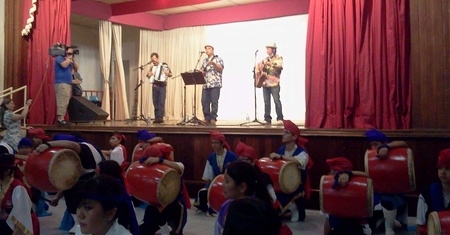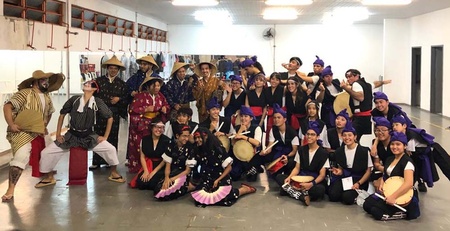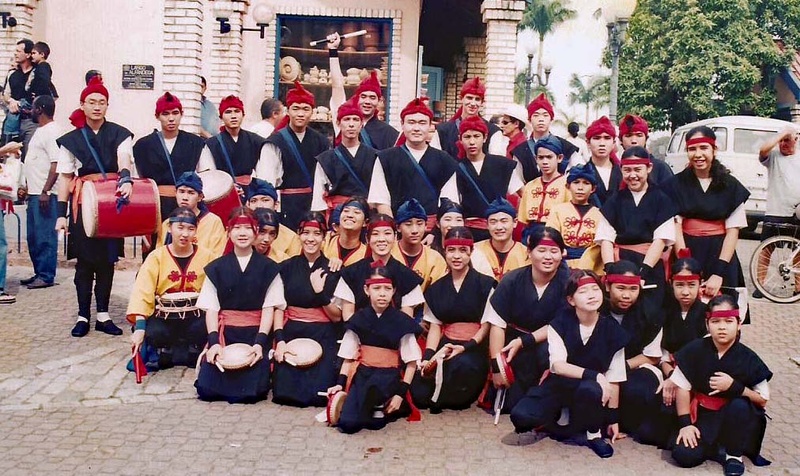Nisei on his father’s side and Sansei on his mother’s, Tadashi Gabriel Nishihira Katsuren, 31, traces his roots to the Okinawa Prefecture and is the owner of a soba restaurant that is commonly found in that part of the world. He has played taiko since his adolescence, thus totaling 16 years of experience. In 2008, he became a member of the group Kariyushi Eisá Daiko of Campo Grande [in the midwestern state of Mato Grosso do Sul], of which he is the leader since October-November 2023, having previously held that position between 2011 and 2013.
History
The beginning
According to Katsuren, in 2000 the Okinawa Association of Campo Grande decided to form an eisa group that would be “empowered by great motivators.” Two years later, a visit from the group Ryukyu Koku Matsuri Daiko (RKMD) – which had been founded in 1982 in Okinawa, and that by then consisted of thousands of members and branches in Japan, Brazil, Argentina, Bolivia, the United States, Mexico, and Peru – led to the start of training sessions that mixed various Ryukyu choreographies with those of the Supá Eisá group and featured dances with a well-defined beat. And that’s how the group was officially launched.
Other youths joined these precursors and the initial name was created: Kariyushi Taiko. Kariyushi expresses the idea of celebration, a good omen; it means “harmony with nature.” The word comes from the term karui ishii – or “pumice stone,” known for staying afloat in water – which is an expression sailors used when praying for a safe voyage. Its meaning has changed over time and nowadays it’s considered a good luck charm.
Later on, in 2005, the group received an invitation to join the RKMD and it was then split into two. At that time, the association's board of directors was not in favor of the affiliation with the RKMD, as the bond between the association and the group would be lost. As a result, some of the group members left “to form the RKMD Campo Grande branch, while others remained in the association and forged ahead with the Kariyushi Taiko.”

Growth and changes
“Taking advantage of a flurry of new members and the excitement generated by the centenary of Japanese immigration in 2008, Kariyushi Taiko grew to nearly 150 active members. Their choreographies evolved into copies of the choreographies of Okinawan groups that were then mixed with original creations or those inspired by other groups,” says Tadashi. At that time, the group's style could be classified as sousaku eisa, “more contemporary, a result of RKMD’s launch in Japan, which featured dances to the beat of pop music and other recent songs, and that had the goal of spreading Okinawan culture.”
With the passing of time, Kariyushi continued to grow thanks to the formation of new generations of coordinators, dancers, and leaders. An important event took place in 2014: The visit of Kenji Maeshiro, a former member of the Ageda neighborhood’s youth group (Ageda Seinenkai). The visit had been arranged through a cultural incentive program offered by the Okinawan government; Maeshiro’s duty was to teach eisa at the association. “On that occasion, we held a whole week of eisa training. We performed dentô eisa, which is the more traditional and folkloric style from the island of Okinawa – a little further away from modern music and much closer to the roots of that culture,” he explains.
Four years later, in 2018, Professor Maeshiro's choreographies were revived, and the group, now known as Kariyushi Eisá Daiko, completely converted to the dentô style. Dentô eisa is the style performed in Okinawa during Obon (three-day event honoring the dead). The performance consists of rhythmic movements to the sound of the dancers’ drum beating. Each neighborhood has its own seinenkai; these organize themselves into eisa groups that dance in the streets, celebrating the culture of their ancestors. Between July and September, youth groups rehearse before performing at various festivals that take place throughout the region.
For two years in a row, in 2018 and 2019, Kariyushi Taiko traveled to the city of São Paulo to participate in the Okinawa Festival (held by the Okinawa Association of [the neighborhood of] Vila Carrão since 2004), thus experiencing yet another moment of great excitement among its members. It was during this period that the group's cultural weight was increased, as its leaders offered lessons and explanations about the origins of the traditions.

The pandemic and a fresh start
With the start of the Covid-19 pandemic, the group entered a phase of stagnation resulting from social isolation. Consequently, there was a reduction in the number of members and activities over the following years. “Until, at the end of 2023, I once again returned to the leadership. We began restructuring our training model and the way our members decide which instrument to play. We also held calls for new members and training classes to rebuild the group, which had on average about five active members at the time,” he says.
Currently, the group’s 25 active members continue to perform in the dentô style. And, according to some research carried out by Tadashi himself, Kariyushi is the only Latin American group that has chosen this eisa subgenre – besides being one of the few on the American continent to perform in that style with such focus and frequency.
Among the values of the Kariyushi Eisá Daiko are those aimed at “the preservation of Okinawan culture; the celebration through dance of the history of the ancestors; and the creation of a friendly and convivial environment where those who are descendants and supporters of Okinawa are able to not only exchange experiences but also preserve and hand down Okinawan culture to future generations.”
Identity
“My family and I have always had many Okinawan customs that play an intrinsic role in our lives, our food, our religion, our habits. My father and my grandparents speak only in Uchinaguchi [the Okinawan dialect]. But all of that is just a part of the Okinawa I got to know,” he explains.
This Nisei-Sansei went from adolescence to adulthood as a member of the eisa group. “Kariyushi shaped much of the person I am today. Memories of one of the best times of my life, the friendships that continue to this day, the excitement of meeting countless generations of new players, and, of course, the feeling of playing eisa, of preserving some of the culture of my ancestors.”
“The group, the customs, the people, and the connection with the rest of the kaikan [regional cultural association] made me understand another part of Okinawa that I was unaware of: eisa, buyo [dance], minyo [traditional Japanese folk songs], sanshin [stringed musical instrument typical of Okinawa],” he adds. “All in all, becoming a Kariyushi member is what made me truly understand what it means to be someone of Okinawan descent,” he concludes.
Cultural legacy
Considering that Kariyushi was the first eisa group in the state of Mato Grosso do Sul and the significant number of people of Okinawan descent in Campo Grande and in that whole region, “the importance of the group within the cultural landscape of the Okinawan community is immeasurable.” Kariyushi is also notable as one of the only groups – if not the only one – in all of Latin America to play in the dentô eisa style. “And this, in itself, has great relevance to the preservation of the culture that is being perpetuated by the group’s legacy.”
Tadashi recalls that, after the performance at the 2019 Okinawa Festival, an elderly woman insisted on sharing her thoughts. “She said something along these lines: ‘I came from Okinawa and I really like the groups from Brazil: Requios, Matsuri Daiko... But the taiko you play is just like what is played in the place where I was born.’ She then thanked us for preserving that culture and for reviving that memory.” Considering this story, there are surely many others who are and will be moved by the eisa rhythms.
© 2024 Tatiana Maebuchi






